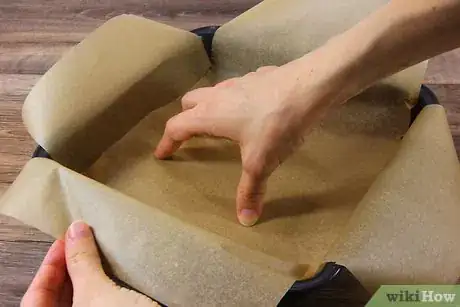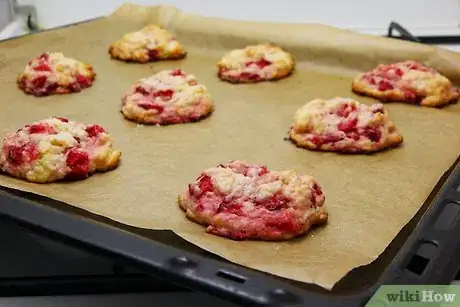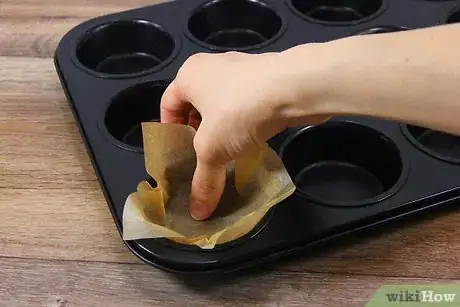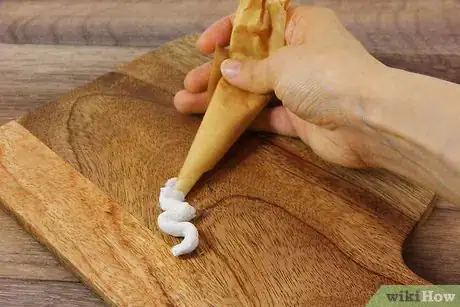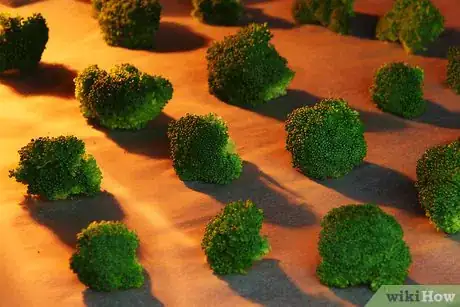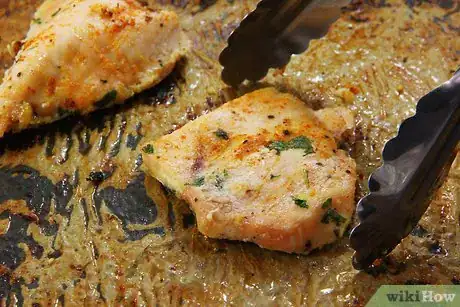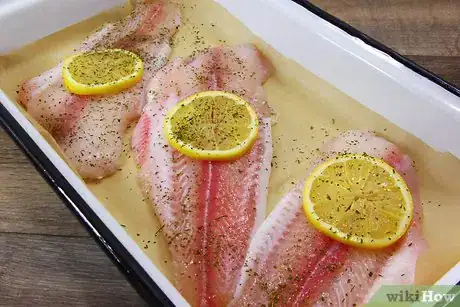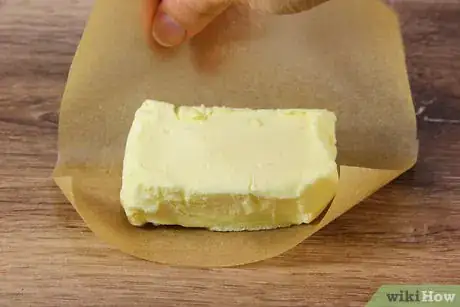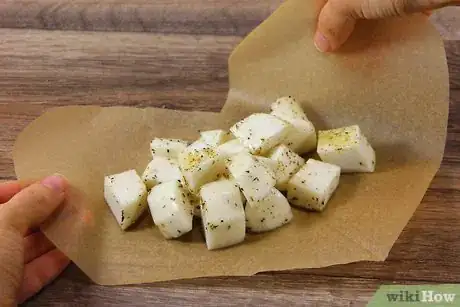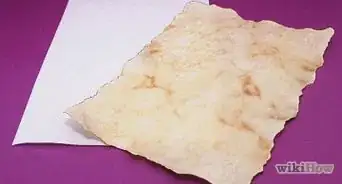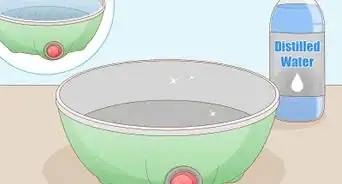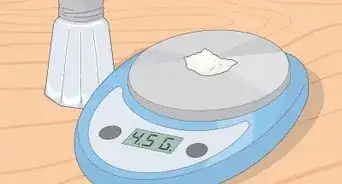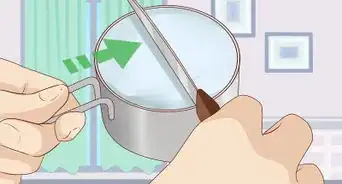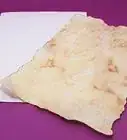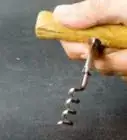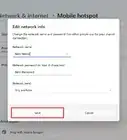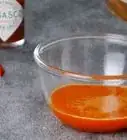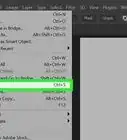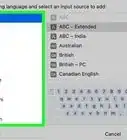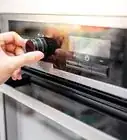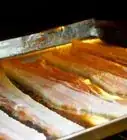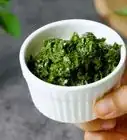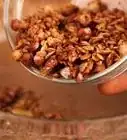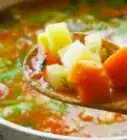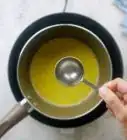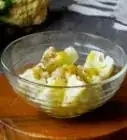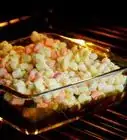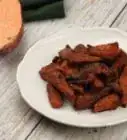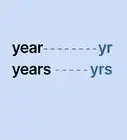This article was co-authored by wikiHow Staff. Our trained team of editors and researchers validate articles for accuracy and comprehensiveness. wikiHow's Content Management Team carefully monitors the work from our editorial staff to ensure that each article is backed by trusted research and meets our high quality standards.
This article has been viewed 283,412 times.
Learn more...
Parchment paper, also often called “baking paper,” is a super handy item to have in your kitchen! It can be used on baking sheets, inside cake pans, and on other baking containers to act as a barrier between the dish and the food being baked or cooked. It keeps food from sticking or burning on the baking dish, and it makes food much easier to remove from those dishes once they’ve been cooked.
Steps
Creating Baked Treats with Parchment Paper
-
1Use parchment paper to make brownies and cakes so they don’t stick. Cut a piece of parchment paper to fit the bottom of a baking tray. Make it long enough so that the edges of the paper extend over the lip of the tray 1 to 2 inches (2.5 to 5.1 cm). Cut a second piece of parchment paper to go the opposite direction across the tray so that all the edges are covered. Pour the batter in on top of the parchment paper. When the brownies or cake are done cooking, simply lift the parchment paper out of the baking tray to easily remove the baked goods.[1]
- For a round cake tin, cut a circle of parchment paper for the bottom of the tray, and then grease or butter the sides of the tin like you normally would.
- To keep the parchment paper itself from slipping, spray just a little bit of cooking spray or add some grease to the corners. This will make the parchment paper stick to the sheet or tray, and it won’t move when you start adding batter or cookies to it.[2]
-
2Keep your counters clean by decorating baked goods on parchment. When you need to drizzle sauces or decorate baked goods with sprinkles, lay them out on parchment paper before you begin. After you’ve finished decorating things, simply throw away the parchment paper.[3]
- For extra help containing those sprinkles, lay the parchment paper on a baking sheet that has an edge around it. That way the sprinkles will stay on the parchment paper and in the baking sheet, no matter what.
Advertisement -
3Line a baking sheet to keep cookies from sticking. The next time you bake cookies, cut a piece of parchment paper to fit the bottom of your baking sheet. Place the cookies on the parchment paper, and then cook them as you normally would.[4]
- The parchment paper distributes the heat to the cookies more evenly, keeps the bottoms from burning, and prevents the cookies from spreading too wide as they bake.
-
4Cut 5 inches (13 cm) squares to put in the bottom of muffin tins. When making muffins, cut out a parchment square for each individual tin. Place a square into each tin, and then press them down with a thin glass, so that the bottom creases around the edges of the tin. Then pour in your batter and cook the muffins according to the recipe.[5]
- When the muffins are done baking, you should be able to turn them out easily onto a clean linen towel and peel the parchment off of the bottoms of the muffins.
-
5Fashion a pastry bag out of parchment paper to decorate baked goods. Take a square of parchment paper, and roll it into a cone shape. Fill it with frosting, snip off the end of the cone with a pair of scissors, and decorate your baked goods![6]
- You won’t get any pretty designs in your frosting from the parchment paper pastry bag, but it’ll allow you to frost and decorate baked goods when you find yourself without a real pastry bag.
Cooking Savory Goods with Parchment Paper
-
1Roast veggies and acidic fruits on parchment paper. Veggies will be easy to clean up, and fruits like strawberries or tomatoes will have a great flavor. Lay a piece of cut parchment paper over a baking sheet, and layer your fruits or veggies evenly across it. Bake them as you normally would, and throw away the parchment paper when they’re done.[7]
- Aluminum pans can make acidic fruits taste really bitter, and the acid from the fruits could also react with the pan, causing damage.
- Some vegetables cook better with aluminum foil rather than parchment paper: potatoes, beets, corn, and cauliflower get softer in aluminum foil than they would if cooked on parchment paper.[8]
-
2Use parchment paper to roast tender, juicy meats. Whether you’re cooking chicken, beef, or pork, cut out a sheet of parchment paper to fit on the bottom of a baking sheet. Place the prepared protein on the baking sheet, and cook it in the oven as you normally would. Once you’re done with your meal, simply throw out the parchment paper.[9]
- If you’re roasting an entire chicken or turkey, use aluminum foil rather than parchment paper. The foil will keep that quantity of meat more moist than parchment paper would.
-
3Protect fish by cooking fillets on a sheet lined with parchment paper. Cooking fish directly on a baking sheet often results in the skin of the fish sticking to the pan. Line the sheet with parchment paper, and cook the fish on that instead. When the fish is done, it should easily slide off of the paper.[10]
- This is an especially great method to use when cooking fish that still has its skin on.
-
4Roll specialty homemade butters in parchment paper. Butter infused with different herbs is delicious and makes a great gift. After you’ve made the butter, put it in the middle of a large piece of parchment paper. Then use the paper to mold and roll the butter into whatever shape you’d like, whether that’s a round ball or a log.[11]
- You can use this same method for rolling out slice-and-bake cookie dough.
-
5Make a steaming pouch out of parchment paper for vegetables. Fold a 14 by 12 inches (36 by 30 cm) piece of parchment paper in half, and then cut the paper into the shape of a heart. Put your prepared veggies (and fish, too, if you want) in the middle of the parchment paper. Roll the edges of the parchment paper up toward the vegetables as tightly as you can, creating a seal overtop of them. Put the parchment packet on a baking sheet, and bake them like you normally would.[12]
- The parchment can come up over the veggies, or it can just create walls around the ingredients. Either way, you should get steamed veggies and have very little left to clean up.
-
6Line a baking dish with parchment paper when making casseroles. Cut a piece of parchment paper to fit your baking dish, with the edges of the paper coming up slightly higher than the natural edge of the dish. Cut a second sheet of parchment paper to lay in the dish going the opposite direction so that all sides are covered with paper. Pour or assemble the casserole inside the lined dish, and bake it in the oven. When the casserole is done and has cooled for 10 minutes, lift the entire thing out of the oven by grabbing the protruding ends of parchment paper.[13]
- This also makes it a lot easier to cut the casserole. Just do it on top of the parchment paper, and then throw it out or compost it once you’re done.
Community Q&A
Did you know you can get answers researched by wikiHow Staff?
Unlock staff-researched answers by supporting wikiHow
-
QuestionCan you cook meat on parchment paper?
 wikiHow Staff EditorThis answer was written by one of our trained team of researchers who validated it for accuracy and comprehensiveness.
wikiHow Staff EditorThis answer was written by one of our trained team of researchers who validated it for accuracy and comprehensiveness.
Staff Answer wikiHow Staff EditorStaff Answer
wikiHow Staff EditorStaff Answer -
QuestionHow long can parchment paper stay in the oven?
 wikiHow Staff EditorThis answer was written by one of our trained team of researchers who validated it for accuracy and comprehensiveness.
wikiHow Staff EditorThis answer was written by one of our trained team of researchers who validated it for accuracy and comprehensiveness.
Staff Answer wikiHow Staff EditorStaff Answer
wikiHow Staff EditorStaff Answer -
QuestionCan you put parchment paper in the oven by itself?
 wikiHow Staff EditorThis answer was written by one of our trained team of researchers who validated it for accuracy and comprehensiveness.
wikiHow Staff EditorThis answer was written by one of our trained team of researchers who validated it for accuracy and comprehensiveness.
Staff Answer wikiHow Staff EditorStaff AnswerParchment paper is oven-safe up to pretty high temperatures (around 450° F), so putting it in the oven by itself should be okay as long as you don’t turn the temperature up too high. Avoid letting the paper come into direct contact with any heating elements, since this could cause it to burn or release unpleasant fumes.
wikiHow Staff EditorStaff AnswerParchment paper is oven-safe up to pretty high temperatures (around 450° F), so putting it in the oven by itself should be okay as long as you don’t turn the temperature up too high. Avoid letting the paper come into direct contact with any heating elements, since this could cause it to burn or release unpleasant fumes.
Warnings
- Never use parchment paper in the broiler! It can burst into flames if it gets too close to the broiler.[14]⧼thumbs_response⧽
Things You’ll Need
- Parchment Paper
- Scissors
References
- ↑ https://www.epicurious.com/expert-advice/parchment-paper-tricks-baking-roasting-article
- ↑ https://www.thekitchn.com/baking-tip-how-to-line-a-bakin-122318
- ↑ https://www.epicurious.com/expert-advice/parchment-paper-tricks-baking-roasting-article
- ↑ https://www.realsimple.com/food-recipes/cooking-tips-techniques/parchment-paper-or-foil
- ↑ https://www.epicurious.com/expert-advice/parchment-paper-tricks-baking-roasting-article
- ↑ https://www.epicurious.com/expert-advice/parchment-paper-tricks-baking-roasting-article
- ↑ https://www.epicurious.com/expert-advice/parchment-paper-tricks-baking-roasting-article
- ↑ https://www.realsimple.com/food-recipes/cooking-tips-techniques/parchment-paper-or-foil
- ↑ https://thepioneerwoman.com/food-and-friends/7-reasons-to-use-parchment-paper/
- ↑ https://www.epicurious.com/expert-advice/parchment-paper-tricks-baking-roasting-article
- ↑ https://www.epicurious.com/expert-advice/parchment-paper-tricks-baking-roasting-article
- ↑ https://www.bonappetit.com/test-kitchen/inside-our-kitchen/article/how-to-fold-parchment-paper-to-cook-en-papillote
- ↑ https://thepioneerwoman.com/food-and-friends/7-reasons-to-use-parchment-paper/
- ↑ https://www.epicurious.com/expert-advice/parchment-paper-tricks-baking-roasting-article
About This Article
Parchment paper is a handy kitchen essential that won’t burn or melt in the oven. Use it to line your cookware before putting it in the oven to keep your baked goods, roasts, or casseroles from sticking to the pan. You can also use it to make steaming pouches, cupcake or muffin wrappers, or even a DIY piping bag for frosting. Making a messy treat? Lay out a bit of parchment paper on your counter to keep it clean. For tips on using parchment paper to make a steaming pouch, read on!
